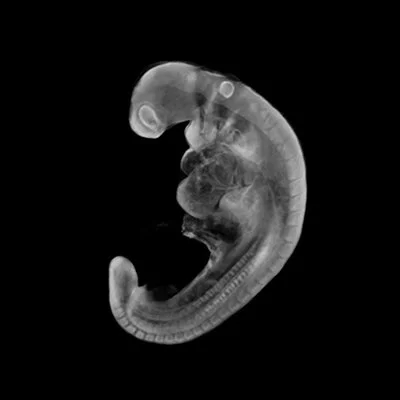Field Note 02: The Gap
Begin the series with Field Note 01: Opening the Notebook
Around the world, humans are wobbling.
Their relationships are wobbling.
Institutions are wobbling.
Whole systems are wobbling.
We see it in the rise of anxiety, addiction, racial violence, and suicide. Every discipline from education to medicine to politics is asking its own version of why, and more importantly what to do about it.
bramble & bone asserts that understanding both the why and the what requires a paradigm shift, using information that has been right in front of us, but scattered and decentralized, this whole time.
Human beings (and most lifeforms) are first and foremost a nervous system.
Human embryo at Carnegie Stage 11. The neural tube — the earliest form of the central nervous system — is already the most active structure in the body.
Image credit: Human Developmental Biology Resource (HDBR) Atlas • CC BY-NC 4.0
Anyone who has taken anatomy and physiology, or read even a basic fetal development text, learned this. The neural tube forms in weeks six to eight. Before the heart beats, the body forms the ability to feel.
We learned this, and then we ignored it.
The medical establishment has divided the body into parts and, in doing so, implied that each part was autonomous. Your lungs are doing this, your stomach is doing that. We talk as if the body is a committee of organs with a noisy narrator sitting on top. And the nervous system is just one organ among many.
Except it is not.
It is the system that rules them all, overriding the brain at times. We all intuitively know this. It slips into our language:
gut instinct
the vibe in the room changes
someone feels off before we can say why
instant trust or distrust without logic
chills or goosebumps at truth
stomach drop when something is wrong
hair standing up on the back of your neck
“I just had a feeling…”
Before the brain can formulate a thought, your peripheral nervous system has already sent information to your central and autonomic systems. Whether to fight, flee, freeze, or fawn is not a decision your cerebrum makes. It is a reflex your nervous system executes.
And right now, at this point in history, we are watching a world caught in collective freeze and fight mode.
The nervous system will not allow the brain to connect or create until it feels safe. Yet we have been asking a whole population carrying generational and stacked traumas to relate and create their way out of crisis for decades.
“The Gen Z stare” says it all; people are frozen in place. If you were told to build a future while crossing a swinging rope bridge over a ravine, you would stand still too. That is what the future feels like for too many: no financial security, shrinking job prospects, political systems sliding into religious nationalism, rising rage propaganda, and global isolationism.
What the nervous system needs is a
solid staircase underfoot
before it can trust the next step.
That is both a physical and psychological truth.
The nervous system moves at the speed of trust, and no faster.
And that is what bramble & bone aims to do, to help institutions and systems shift their lens toward understanding humans, and the beings we co-regulate with, as nervous systems with non-negotiable needs. To redesign environments that support, rather than punish, sensory and emotional reality. (I’m looking at you, fluorescent lights and loud background music.)
If we start here, maybe we can stop asking:
why children cannot learn
why people vote against their own interests
why abuse victims return to their abusers
how to stem the incarceration pipeline
what addiction actually is
and so many of the questions haunting our time
We will keep sharing our work as we build.
References:
Kerwin J, Yang Y, Merchan P, Sarma S, Thompson J, Wang X, Sandoval J, Puelles L, Baldock R and Lindsay S. The HUDSEN Atlas: a three-dimensional (3D) spatial framework for studying gene expression in the developing human brain. J Anat 2010, 217 (4):289-299.
Gerrelli D, Lisgo S, Copp AJ, Lindsay S (2015) Enabling research with human embryonic and fetal tissue resources. Development 142:3073-6. doi: 10.1242/dev.122820.
